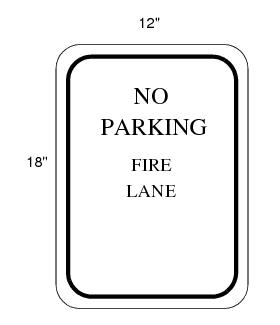10.36.175 Fire lanes.
A. Definitions. The following definitions shall apply in the interpretation and enforcement of this section:
1. “Fire lane” means that area within any public right-of-way, easement, or private property designated for the purpose of permitting fire trucks and other fire-fighting or emergency equipment to use, travel upon and park.
2. “Park,” “parking,” “stop,” “stand” or “standing” means the halting of a vehicle, other than an emergency vehicle, whether occupied or not, except when necessary to avoid conflict with other traffic or in compliance with the directions of a police officer or fire official or traffic-control sign or signal.
3. “Vehicle” means a machine propelled by power other than human power, designed to travel along the ground or rail by use of wheels, treads, runners or slides, and transport persons or property, or pull machinery, and shall include, without limitations, automobile, truck, trailer, motorcycle, tractor, buggy, wagon and locomotive.
B. Requirements – Standards. When required by the fire department, hard-surfaced driving lanes shall be provided around facilities which by their size, location, design or contents warrant access which exceeds that normally provided by the proximity of city streets.
1. Lanes shall provide a minimum, unobstructed continuous width of 20 feet and a minimum vertical clearance of 13 feet, 6 inches.
2. Fire lanes shall be either asphalt or reinforced concrete, or when specifically authorized by the fire department, compacted crushed rock may be used.
3. Where fire lanes connect to city streets or parking lots, adequate clearances and turning radii shall be provided. All proposed plans must have fire department approval.
C. Fire Lanes as Part of Driveways and/or Parking Areas. The fire department may require that areas specified for use as driveways or private thoroughfares shall not be used for parking. These areas, when specified, shall be marked or identified by one of the two means detailed in subsection E of this section.
D. Parking in a Fire Lane Prohibited. Except when necessary to avoid conflict with other traffic, or in compliance with the direction of a police officer or fire official or traffic-control sign, signal or device, no person shall stop, stand or park a vehicle, whether occupied or not, in a designated fire lane. Vehicles parked in a fire lane are subject to immediate impoundment, in addition to other penalties.
E. Fire Lane Identification. Lanes shall be identified by a four-inch-wide line or by painting of the curb in bright yellow color. Marking shall be by one of the following methods:
1. Fire lane signs (in accordance with the Washington State Highway Commission Sign Fabrication Manual M24-70 HT and the Manual of Uniform Traffic-Control Devices issued by the Federal Highway Administration), per illustration:

Lettering Specifications
3" – Class C width
3" – Class B width
2" – Class C width
1/2" – Class C width
a. Reflective in nature;
b. Red letters on white background;
c. Signs to be spaced 50 feet apart and posted on or immediately next to the curb, or on the building;
d. Signs to be no less than four feet from the ground.
2. Fire lane painting (where signs cannot be safely or securely posted, or where required additional to signs).
a. Block letters 24 inches high, 12 inches wide and four-inch stroke stating “FIRE LANE – NO PARKING” shall be painted on the lane at 50-foot intervals in bright yellow color using paint that shall be suited for traffic markings.
3. Alternate Materials and Methods. The city may modify its method of marking fire lanes if the provisions of this section are impractical. This includes authorizing the city engineer to include references to codes and/or ordinances on the signs, but the inclusion or exclusion of that or any other language shall not affect the enforceability of the fire lane restrictions so long as the sign clearly identifies a fire lane and is in accordance with the Washington State Highway Commission Sign Fabrication Manual M24-70 HT and the Manual of Uniform Traffic-Control Devices issued by the Federal Highway Administration.
F. Existing Buildings. When the fire department determines that a hazard due to inaccessibility of fire apparatus exists around existing buildings, they may require fire lanes to be constructed and maintained as detailed in subsections B and C of this section.
G. Violation. It is a violation of this section for any person, firm or individual to sign or to attempt to designate an unauthorized fire zone.
H. Penalties. Any person violating any of the provisions of this section has committed an infraction and shall be fined $75.00. (Ord. 6247 § 2, 2009; Ord. 5724 § 1, 2002; Ord. 5212 § 1 (Exh. F), 1999; Ord. 5110 § 2, 1998; Ord. 4188 §§ 1 – 9, 1986.)